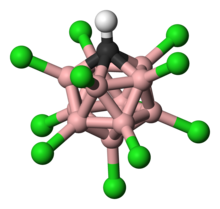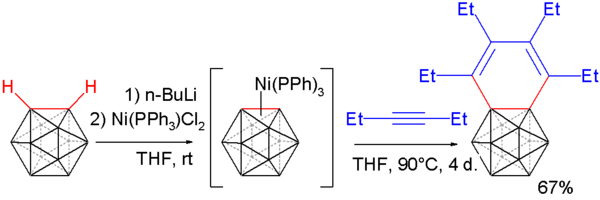Carborà


Un carborà, en anglès: carborane és un compost clúster químic compost per àtoms de bor, carboni i hidrogen. Són polièdrics.
Són exemples interessants de carborans aquells que són icosahèdrics extremadament estables.[1] Aquests clústers rics en bor mostren propietats organomimètiques úniques amb molècules orgàniques metàl·liques[2]
Un exemple de carborà de càrrega neutra és el C₂B10H₁₂ o o-carborà que té molts usos en polímers resistents a la calor i en medicina L’àcid carborà, és un superàcid amb clor, H(CHB11Cl11).
Dicarbadodecaborà[modifica]

El carborà més estudiat és C₂B10H₁₂, m. p. 320 °C. Sovint es prepara per a la reacció amb acetilè amb decaborà. A [3]
Història[modifica]
Els 1,2-closo-dicarbadodecaborans (normalment simplement dits carborans), van ser descoberts de forma simultània per grups d'Olin Corporation i la Reaction Motors Division of Thiokol Chemical Corporation treballant junts per a la U.S. Air Force and published in 1963.[4] Aquest grups van demostrar l'estabilitat sense precedents dels 1,2-closo-dodecaboran grup.
Carborins[modifica]
Caborin, Carboryne, o 1,2-dehydro-o-carboran, és un derivat inestable de l’ortocarboran amb la fórmula B10C₂H10.[5][6][7] Un compost carborin es va generar primer l’any 1990 a partir de l’o-carboran. posteriorment, el resultant dianió del liti reacciona amb brom a 0 °C per formar el monoanió del brom.
Els carborins reaccionen amb alquins per formar benzocarborans [8][9]
Recerca[modifica]
Els carborans han estat explorats com una font de bor en la teràpia de captura de neutrons de bor.[10] També per estudis de cristal·lografia.[11]
Els carborans han estat usats per a fer superàcids sòlids que tenen un avantatge mediambiental sobre els àcids dissolts.[12] El superàcid carboran H(CHB11Cl11) té una constatnt de dissociació un milió de vegades més alta que la de l'àcid sulfúric.[13]
Referències[modifica]
- ↑ Jemmis, E. D. «Overlap control and stability of polyhedral molecules. Closo-Carboranes». Journal of the American Chemical Society, 104, 25, 1982, pàg. 7017–7020. DOI: 10.1021/ja00389a021.
- ↑ Spokoyny, A. M. «New ligand platforms featuring boron-rich clusters as organomimetic substituents». Pure and Applied Chemistry, 85, 5, 2013, pàg. 903–919. DOI: 10.1351/PAC-CON-13-01-13.
- ↑ Kutal, C. R.; Owen, D. A.; Todd, L. J. «Closo-1,2-dicarbadodecaborane(12)». Inorganic Syntheses, 11, 1968, pàg. 19–23. DOI: 10.1002/9780470132425.ch5.
- ↑ Heying, T. L.; Ager, J. W.; Clark, S. L.; Mangold, D. J.; Goldstein, H. L.; Hillman, M.; Polak, R. J.; Szymanski, J. W. «A New Series of Organoboranes. I. Carboranes from the Reaction of Decaborane with Acetylenic Compounds». Inorganic Chemistry, 2, 6, 1963, pàg. 1089–1092. DOI: 10.1021/ic50010a002.Schroeder, H.; Heying, T. L.; Reiner, J. R. «A New Series of Organoboranes. II. The Chlorination of 1,2-Dicarbaclosododecaborane(12)». Inorganic Chemistry, 2, 6, 1963, pàg. 1092–1096. DOI: 10.1021/ic50010a003.Heying, T. L.; Ager, J. W.; Clark, S. L.; Alexander, R. P.; Papetti, S.; Reid, J. A.; Trotz, S. I. «A New Series of Organoboranes. III. Some Reactions of 1,2-Dicarbaclosododecaborane(12) and its Derivatives». Inorganic Chemistry, 2, 6, 1963, pàg. 1097–1105. DOI: 10.1021/ic50010a004.Papetti, S.; Heying, T. L. «A New Series of Organoboranes. IV. The Participation of the 1,2-Dicarbaclosododecaborane(12) Nucleus in Some Novel Heteratomic Ring Systems». Inorganic Chemistry, 2, 6, 1963, pàg. 1105–1107. DOI: 10.1021/ic50010a005.Fein, M. M.; Bobinski, J.; Mayes, N.; Schwartz, N.; Cohen, M. S. «Carboranes. I. The Preparation and Chemistry of 1-Isopropenylcarborane and its Derivatives (a New Family of Stable Closoboranes)». Inorganic Chemistry, 2, 6, 1963, pàg. 1111–1115. DOI: 10.1021/ic50010a007.Fein, M. M.; Grafstein, D.; Paustian, J. E.; Bobinski, J.; Lichstein, B. M.; Mayes, N.; Schwartz, N. N.; Cohen, M. S. «Carboranes. II. The Preparation of 1- and 1,2-Substituted Carboranes». Inorganic Chemistry, 2, 6, 1963, pàg. 1115–1119. DOI: 10.1021/ic50010a008.Grafstein, D.; Bobinski, J.; Dvorak, J.; Smith, H.; Schwartz, N.; Cohen, M. S.; Fein, M. M. «Carboranes. III. Reactions of the Carboranes». Inorganic Chemistry, 2, 6, 1963, pàg. 1120–1125. DOI: 10.1021/ic50010a009.Grafstein, D.; Bobinski, J.; Dvorak, J.; Paustian, J. E.; Smith, H. F.; Karlan, S.; Vogel, C.; Fein, M. M. «Carboranes. IV. Chemistry of Bis-(1-carboranylalkyl) Ethers». Inorganic Chemistry, 2, 6, 1963, pàg. 1125–1128. DOI: 10.1021/ic50010a010.Grafstein, D.; Dvorak, J. «Neocarboranes, a New Family of Stable Organoboranes Isomeric with the Carboranes». Inorganic Chemistry, 2, 6, 1963, pàg. 1128–1133. DOI: 10.1021/ic50010a011.
- ↑ Gingrich, H. L.; Ghosh, T.; Huang, Q.; Jones, M. «1,2-Dehydro-o-carborane». Journal of the American Chemical Society, 112, 10, 1990, pàg. 4082–4083. DOI: 10.1021/ja00166a080.
- ↑ Jemmis, E. D.; Kiran, B. «Structure and Bonding in B10X₂H10 (X = C and Si). The Kinky Surface of 1,2-Dehydro-o-Disilaborane». Journal of the American Chemical Society, 119, 19, 1997, pàg. 4076–4077. DOI: 10.1021/ja964385q.
- ↑ Kiran, B.; Anoop, A.; Jemmis, E. D. «Control of Stability through Overlap Matching: closo-Carboranes and closo-Silaboranes». Journal of the American Chemical Society, 124, 16, 2002, pàg. 4402–4407. DOI: 10.1021/ja016843n.
- ↑ Deng, L.; Chan, H.-S.; Xie, Z. «Nickel-Mediated Regioselective [2 + 2 + 2] Cycloaddition of Carboryne with Alkynes». Journal of the American Chemical Society, 128, 24, 2006, pàg. 7728–7729. DOI: 10.1021/ja061605j. PMID: 16771473.
- ↑ Jemmis, E. D.; Anoop, A. «Theoretical Study of the Insertion Reactions of Benzyne- and Carboryne- Ni Complexes» (pdf). Maui High Performance Computing Center Application Briefs. Air Force Maui Optical & Supercomputing Site (AMOS), 2004, 2004, pàg. 51. Arxivat de l'original el 2006-07-13 [Consulta: 12 gener 2016]. Arxivat 2006-07-13 a Wayback Machine.
- ↑ Soloway, A. H.; Tjarks, W.; Barnum, B. A.; Rong, F.-G.; Barth, R. F.; Codogni, I. M.; Wilson, J. G.; Tjarks; Barnum; Rong; Barth; Codogni; Wilson «The Chemistry of Neutron Capture Therapy». Chemical Reviews, 98, 4, 1998, pàg. 1515–1562. DOI: 10.1021/cr941195u. PMID: 11848941.
- ↑ Zhang, D. P.; Dou, J. M.; Li, D. C.; Wang, D. Q. «Di-μ-chlorido-bis{[1,2-bis(diphenylphosphino)-1,2-dicarba-closo-dodecaborane-κ²P,P']silver(I)} dichloromethane disolvate». Acta Crystallographica E, 63, 4, 2007, pàg. m1086–m1088. DOI: 10.1107/S1600536807007088.
- ↑ Olah, G. A.. A Life of Magic Chemistry: Autobiographical Reflections of a Nobel Prize Winner. John Wiley and Sons, 2001, p. 105. ISBN 0-471-15743-0.
- ↑ Olah, G. A.; Prakash, G. K. S.; Sommer, J.; Molnar, A. Superacid Chemistry
Enllaços externs[modifica]
- Material Safety Data Sheet Arxivat 2012-03-13 a Wayback Machine.



